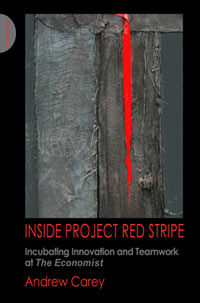|
Imprint: Triarchy Press
Published: 2008 List Price: £20.00 Offer Price: £16.00 Format: Paperback Extent: 232pp. Size: 15 x 23 cm ISBN: 978-0-9550081-6-0 Tags: Innovation, Teamwork, Design Thinking, The Economist Inside Project Red Stripe: Incubating Innovation and Teamwork at The Economist Andrew Carey Book Page About the author Contents Buy the book
Paperback:
|
those ideas in full
Regent's Park, 5th February 2007
Here are the ideas the team shared at the very start in a meeting mentioned in maps: Steve's presentation was not so much a thought-out idea as a gathering of thoughts. Many Economist readers, he supposed, would have sent a letter to the editor and would have moved from being communication Luddites to being heavy Internet users, but probably wouldn't download a podcast. Were there any low-hanging fruits, perhaps an 'online weekend companion', perhaps a sort of digital Intelligent Life (The Economist's 'engaging lifestyle magazine')? Perhaps there were synergies to be derived from combining data from The Economist's 'World In' and 'Cities' Guide', with local community information and blogs? Perhaps a way could also be found to secure weekend advertising through a new service like this? Subsequent discussion focused on covering leisure, presenting advertising in a more relaxed environment and easing the transition into the digital life. Tom used chairs to display his hand-written posters (PowerPoint happily wasn't possible in the park). Influenced in particular byNetvibes' web content aggregator and personalised portal service and the way in which he consumed the web, he presumed that this kind of behaviour would become more widespread. He proposed an 'Economist Reader' homepage service, which would combine comments by magazine readers on Economist articles, a bookmark feature (like de.licio.us) to enable users to find out what other Economist readers are looking at on the web, a community-based service echoing digg pages for citizen journalists, an 'Economist Sandbox' (a little like the Wikipedia Sandbox) in which readers could play with Economist data and repackage them and a profile page where users could put up their CV Facebook-style. There was much discussion of The Economist's intelligent readership, how much it has to say and how much readers have to offer each other. Stewart's proposal didn't specifically relate to The Economist Group and was much more broad-brush in its approach. It took as its starting point the idea that the Internet is about communication rather than information. Why not, he asked, let people create interest groups and subscriptions within given geographical areas, helping to find local services, a football team or somebody to have a date with? Economist readers want to meet other Economist readers, and a service like this could be combined with geolocation technology. Discussion centred around existing services like twitter and the more business-orientated linked in and why they were more popular in Asia than in Europe. Joanna's proposal tended to ask questions rather than offer solutions. Before coming up with ideas of what to do, she felt the team should ask things like:
Everyone agreed that this was an important corrective to the previous discussion they'd been having. Ludwig's idea, as you'll have guessed, was 'Economist.kids'. He proposed using The Economist's data, skills, resources, reputation and values to create an Economist-like service aimed at a much younger audience. It could include a moderated Wiki, advise on job seeking, writing and all aspects of learning as well as offering financial and political information and news. Much of the discussion was around how to commercialise this service without alienating the target audience. It was very early on and Mike, in leader/facilitator role, didn't bring a proposal to the park. Following these ideas through the project, you'll have noticed that Ludwig's Economist.kids proposal made it through to the last two in April, largely due to its author's enthusiasm for the project. Or, as his Myers-Briggs profile said: 'May appear so unyielding that others are afraid to approach or challenge them.' When the Bavaria/Lughenjo idea emerged, centring on universal primary education and a broader philanthropy exchange, it had no real roots in any of the above ideas (except that Intelligent Life has a strong philanthropy theme), although it was the result of returning to Joanna's 'what do people need?' approach. But the final HiSpace social/knowledge network proposal had obvious roots in Tom's idea and in some of the discussions they'd had in the park in early February. |

